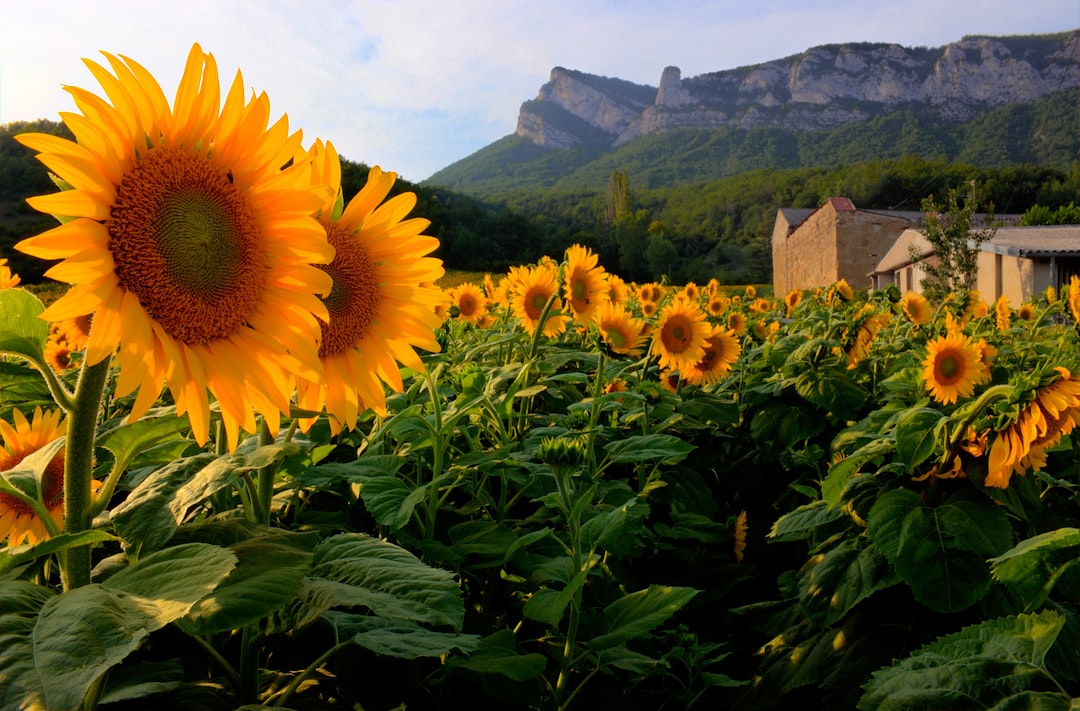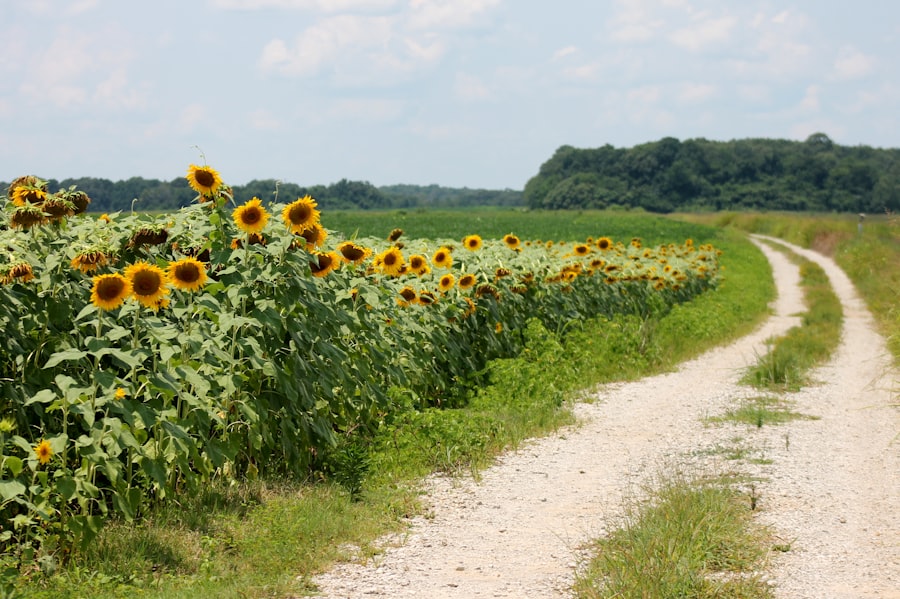Harvesting Sunflowers: A Step-by-Step Guide

Sunflowers are not only beautiful to look at, but they also have a variety of uses. From their vibrant yellow petals to their nutritious seeds, sunflowers are a versatile plant that can be enjoyed in many different ways. Whether you want to use them for decorative purposes, as a source of food, or for their oil, proper harvesting techniques are essential to ensure optimal yield and quality.
Harvesting sunflowers involves the process of collecting the mature seeds from the flower heads. This is typically done when the petals have dried and fallen off, and the back of the flower head has turned brown. The seeds can then be used for various purposes such as snacking, baking, or even pressing for oil. However, it is important to note that not all sunflower varieties are suitable for harvesting. Some varieties are bred specifically for their ornamental value and may not produce viable seeds.
Key Takeaways
- Select the right sunflower variety for harvesting based on your climate and intended use.
- Prepare the soil by removing weeds and adding compost or fertilizer before planting sunflowers.
- Plant sunflowers in rows with adequate spacing and water regularly to ensure optimal yield.
- Care for sunflowers by monitoring for pests and diseases, and providing support for taller varieties.
- Determine when sunflowers are ready for harvest by checking the back of the flower head for dry, brown seeds.
- Tools and equipment needed for sunflower harvesting include pruning shears, gloves, and a bucket or basket.
- Harvest sunflowers by cutting the stem below the flower head and allowing them to dry in a warm, dry place.
- Post-harvest care involves removing the seeds from the flower head and storing them in a cool, dry place.
- Utilize harvested sunflowers in recipes such as roasted seeds, sunflower butter, and salads.
Selecting the Right Sunflower Variety for Harvesting
When choosing a sunflower variety for harvesting, there are several factors to consider. First and foremost, you need to determine whether you want to grow sunflowers for their seeds or for decorative purposes. If you are interested in harvesting the seeds, it is important to select a variety that is known for its high seed production.
Popular sunflower varieties for harvesting include the Mammoth Russian, which produces large seeds that are perfect for snacking or roasting. Another popular variety is the Autumn Beauty, which produces a mix of different colored flowers and can be used both for decorative purposes and seed production.
Preparing the Soil for Sunflower Harvesting
Sunflowers thrive in well-drained soil that is rich in organic matter. Before planting sunflowers, it is important to prepare the soil properly to ensure optimal growth and yield. Start by removing any weeds or grass from the area where you plan to plant your sunflowers. This can be done by hand or with the help of a garden hoe or tiller.
Once the area is clear of weeds, you can then prepare the soil by loosening it with a garden fork or tiller. This will help improve drainage and allow the sunflower roots to penetrate the soil more easily. Adding compost or well-rotted manure to the soil can also help improve its fertility and provide essential nutrients for the sunflowers.
Planting Sunflowers for Optimal Yield
| Planting Method | Yield (per acre) | Days to Maturity | Seed Cost (per pound) |
|---|---|---|---|
| Direct Seeding | 1,000 lbs | 80-100 days | 2.50 |
| Transplanting | 1,200 lbs | 70-90 days | 3.50 |
| Row Spacing: 30 inches | 1,100 lbs | 75-95 days | 3.00 |
| Row Spacing: 36 inches | 900 lbs | 85-105 days | 2.75 |
The best time to plant sunflowers is in late spring or early summer, when the soil has warmed up and there is no longer a risk of frost. Sunflowers require full sun to thrive, so choose a location that receives at least 6-8 hours of direct sunlight per day.
To plant sunflowers, dig a hole that is about twice the size of the root ball of the seedling. Place the seedling in the hole and backfill with soil, gently firming it around the base of the plant. Water thoroughly after planting to help settle the soil and ensure good root-to-soil contact.
Spacing is also important when planting sunflowers for optimal yield. Depending on the variety, sunflowers should be spaced about 1-2 feet apart to allow for proper air circulation and prevent overcrowding.
Caring for Sunflowers During Growth
Proper care during the growth stage is crucial for healthy and productive sunflowers. Watering is important, especially during dry periods, as sunflowers have deep roots that need to be kept moist. Water deeply once or twice a week, making sure to soak the soil thoroughly.
Fertilizing sunflowers can also help promote healthy growth and higher yields. Use a balanced fertilizer with equal amounts of nitrogen, phosphorus, and potassium. Apply the fertilizer according to package instructions, taking care not to over-fertilize as this can lead to excessive foliage growth at the expense of flower and seed production.
Pest and disease management is another important aspect of caring for sunflowers. Common pests that can affect sunflowers include aphids, caterpillars, and birds. Regularly inspect your plants for signs of pest damage and take appropriate measures to control them. Diseases such as powdery mildew and downy mildew can also affect sunflowers, so it is important to monitor your plants and take preventive measures such as proper spacing and good air circulation.
Determining When Sunflowers are Ready for Harvest

Knowing when sunflowers are ready for harvest is crucial to ensure optimal seed production. The first sign that sunflowers are ready for harvest is when the petals have dried and fallen off. The back of the flower head will also turn brown and the seeds will start to develop a black or gray stripe.
To check for maturity, gently press your thumb against one of the seeds. If it feels firm and does not dent easily, the sunflower is ready for harvest. If the seed is still soft or squishy, it needs more time to mature.
Tools and Equipment Needed for Sunflower Harvesting
Harvesting sunflowers requires a few essential tools and equipment. These include:
1. Pruning shears or a sharp knife: These are used to cut the flower heads from the stalks.
2. A basket or bucket: This is used to collect the harvested flower heads.
3. Gloves: Sunflower stalks can be prickly, so wearing gloves can help protect your hands during harvesting.
4. Drying racks or screens: These are used to dry the harvested flower heads before extracting the seeds.
It is important to use the right tools for the job to ensure efficient and effective harvesting.
Harvesting Sunflowers: Techniques and Tips
There are several techniques for harvesting sunflowers, depending on how you plan to use them. If you are harvesting sunflowers for their seeds, the most common method is to cut the flower heads from the stalks using pruning shears or a sharp knife. Leave about 12-18 inches of stem attached to the flower head to allow for easier handling and drying.
If you are harvesting sunflowers for decorative purposes, you can cut the flower heads with longer stems to use in floral arrangements. Remove any leaves from the stem and place the flower heads in a bucket of water to keep them fresh.
When harvesting sunflowers, it is important to handle the flower heads with care to avoid damaging the seeds. Avoid dropping or throwing the flower heads, as this can cause the seeds to become bruised or damaged.
Post-Harvesting Sunflower Care
After harvesting sunflowers, it is important to properly dry and store them to prevent spoilage and maintain quality. Start by removing any remaining petals or debris from the flower heads. Then, spread the flower heads out on drying racks or screens in a well-ventilated area away from direct sunlight.
Allow the flower heads to dry for about 2-3 weeks, or until the seeds are fully dry and can be easily removed from the flower head. To extract the seeds, rub two flower heads together or use your hands to gently separate the seeds from the head.
Once the seeds are dry, store them in airtight containers in a cool, dark place. This will help prevent spoilage and maintain their quality for longer periods of time.
Utilizing Harvested Sunflowers: Recipes and Uses
Harvested sunflowers can be used in a variety of ways. The most common use is for snacking on the seeds, either raw or roasted. Sunflower seeds can also be used in baking, added to salads or granola, or ground into flour for gluten-free recipes.
Sunflower oil is another popular product that can be made from harvested sunflowers. The seeds can be pressed to extract the oil, which can then be used for cooking, salad dressings, or even as a natural moisturizer for the skin.
Proper sunflower harvesting techniques are essential to ensure optimal yield and quality. From selecting the right variety to preparing the soil, planting, and caring for the plants, each step plays a crucial role in the success of your sunflower harvest. By following these guidelines and using the right tools and equipment, you can enjoy a bountiful harvest of sunflower seeds or beautiful flower heads for decorative purposes. So go ahead and give sunflower harvesting a try – you won’t be disappointed!
If you’re looking for expert advice on how to harvest a sunflower, look no further than Lawn World. Their comprehensive guide on sunflower harvesting provides step-by-step instructions and valuable tips to ensure a successful harvest. From determining the right time to harvest to properly drying and storing the seeds, this article covers it all. Check out their website for more gardening tips and tricks.
FAQs
What is the best time to harvest sunflowers?
The best time to harvest sunflowers is when the back of the flower head turns yellow and the petals start to dry out and fall off.
How do I know if a sunflower is ready to be harvested?
A sunflower is ready to be harvested when the back of the flower head turns yellow and the petals start to dry out and fall off. The seeds should also be plump and firm.
What tools do I need to harvest sunflowers?
To harvest sunflowers, you will need a pair of sharp scissors or pruning shears, a bucket or basket to collect the flower heads, and gloves to protect your hands from the prickly stems.
How do I harvest sunflowers?
To harvest sunflowers, use a pair of sharp scissors or pruning shears to cut the flower head from the stem, leaving about 4-6 inches of stem attached. Place the flower heads in a bucket or basket.
What should I do with the harvested sunflowers?
Harvested sunflowers can be used for a variety of purposes, such as making bird feeders, decorating your home, or roasting the seeds for a healthy snack. You can also save the seeds to plant more sunflowers next year.
How do I store harvested sunflowers?
To store harvested sunflowers, hang them upside down in a dry, well-ventilated area for a few weeks until they are completely dry. Once dry, remove the seeds and store them in an airtight container in a cool, dry place.



